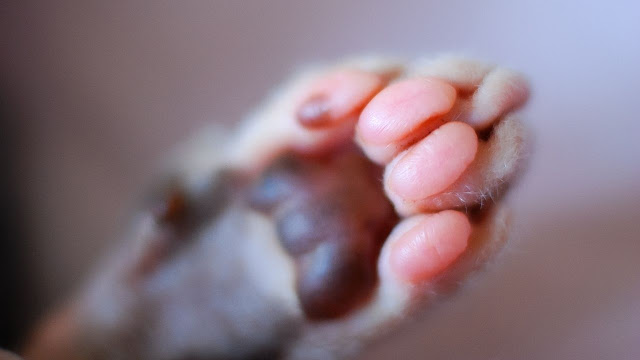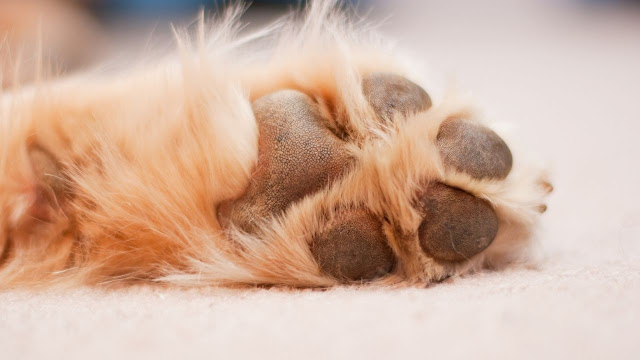Why is my dog paw pad turning pink?
Maintaining the good condition of the dog's paws is essential because they spend most of their time on their paws, whether standing, running, or walking. The paw pads of a dog allow them to grasp surfaces, provide insulation for their feet, maintain balance, and act as shock absorbers for their legs and feet when they are running or jumping.
Reasons why your pup's paw pads may have become pink
There are a variety of factors that might cause a dog's paw pads to become pink. An allergic response of some sort, a lesion, or any number of other difficulties that may arise from a variety of different conditions to which your dog may have been exposed are all possibilities for why this is happening to your dog.
The other possible reasons for pink paw pads in dogs are:
- Aging
- Genetics
- Allergies
- Change in Walking Surface
- Fungal Infections
- Bacterial Infections
- Burns and Blisters
- Cysts, Lumps, and Growths
Whenever the paw pads of your beloved pet suddenly begin to become pink, the animal is likely experiencing significant discomfort, which will severely influence its ability to lay its entire weight on its paws and walk normally.
1. Aging
Puppy paws that are initially pink and gradually become black as the dog grows older are not uncommon. Some dogs, on the other hand, will develop pink paws as they get older. This is referred to as marbling, and it can also have an effect on their nose and lips.
2. Genetics
Pink paws are a natural trait in certain dogs. These canines are unable to create pigment due to a genetic condition. Depending on the breed, this might occur all over the dog's body or simply in certain places, such as the paws.
3. Allergies
An allergy is characterized by hypersensitivity or extraordinary sensitivity to a chemical, such that when the material is inhaled, eaten, or comes into touch with the skin, the body reacts violently and produces symptoms. Dogs, for example, might be affected by a variety of different types of allergies.
Typically, a dog suffering from any sort of allergic response will have itchy paws. It will frequently attempt to relieve the itching by licking, biting, or chewing on its paws to relieve the itching and irritation.
In addition to this, the animal is likely to suffer from additional complications such as skin and ear infections and difficulties with the anal gland. It is truly a vicious cycle since excessive licking by the dog will only result in further damage and irritation to the dog's mouth.
According to experts and authorities in the field of animal health care, a variety of allergic responses in dogs are frequently attributed to food and grass. If the dog's paw pads or hair are light in color, the inflammation will be more visible on the skin's surface.
When you see similar reactions in your dogs, a recommended first step is to remove all grains from their diet altogether. This is because grains have been shown to be a significant contributor to allergy reactions in dogs.
While an allergic response will most often manifest itself as a vivid pink or rusty red discoloration on the dog's feet, it will also cause the dog to lick and chew on both feet excessively, as opposed to injury cases which would typically affect only one foot.
In addition to losing hair around their mouth and nose from frequent licking or biting, dogs suffering from allergies may end up limping if the agony becomes too much for them to bear.
Furthermore, due to the licking and chewing, the animal's paws will be more susceptible to fungal and bacterial infections than they would otherwise be. The fact that your dog is licking its paws excessively indicates that something is wrong, and the pet should be taken to the veterinarian's office as soon as possible for an inspection.
4. Modifications to the walking surface
A change in the walking surface may cause your dog's paws to turn pink. They can be worn down to the delicate pink layer beneath the solid outer layer of their paws when they are exposed to abrasive surfaces like concrete.
In the case of dogs that are used to being indoors or walking on grass but who are now walking on a hard surface such as concrete, gravel, or pavement, this might explain why their pads are becoming pink.
5. Infections caused by fungi
Even though fungal infections in dogs are less prevalent than bacterial or viral infections, they may be just as hazardous as the other types. In general, dogs can get fungal infections from the environment, other animals, or an overgrowth of naturally present fungi on their own bodies. Fungal infections can be fatal in dogs.
A yeast dermatitis infection will generally affect the skin between a dog's toes and other skin folds, although it can affect any part of the dog's body. Redness, dark discoloration, itchiness, and sticky discharge around the paws and toes of dogs are frequently caused by this condition.
As a secondary infection to a more basic disease or issue known as atopic dermatitis, yeast infections are frequently encountered in patients with atopic dermatitis. On the paw pads and feet, the signs that the dog's health has been weakened are considerably more visible than on other areas of the body. An allergic reaction to allergens present in the environment is typically the cause of atopic dermatitis in dogs, which is a kind of inflammatory skin disease.
The results of blood tests and skin tests performed on your dog by your veterinarian will reveal the exact allergens that are causing his atopic dermatitis. The good news is that this disease is readily controlled; thus, it should be addressed as soon as possible to guarantee that Fido's excellent health is restored to him.
Dogs can contract ringworm, a fungal ailment caused by a fungus that can be found in the soil. Typically, your pet may get the illness while playing outside, such as in a dog park. The most accurate method to diagnose this illness, and hence the most effective way to treat it, is to have your veterinarian do a fungal culture of the dog's hair or skin cells or undertake a microscopic analysis of a hair sample.
6. Bacterial Infections
Bacterial infection cause atopic or allergic dermatitis, according to experts. The disease is known as interdigital furunculosis or abscesses (localized skin infection). Dogs can get this condition, which manifests as a pink paw pad or a painful blister filled with pus in severe conditions that affect the webbing between their toes, caused by deep bacterial infection.
This sort of bacterial illness can affect a variety of dog breeds, some of which are listed below:
- Chinese Shar-Peis.
- English Bulldogs
- Labrador Retrievers
These dog breeds have short bristly hairs on the webbing between their toes, distinguishing them from other breeds. While the dog is walking, the short hair shafts are readily pushed back into the hair follicles, which is a common occurrence. Afterward, the ingrown hairs produce irritation on the skin, which might result in subsequent bacterial infections.
Interdigital furunculosis or furuncles are extremely painful and typically cause the dog to become lame or limp on the afflicted foot or feet, depending on the severity of the condition. This condition generally affects the forefoot, and numerous new furuncles may appear while the existing ones heal.
This is due to the fact that a bacterial infection is the underlying cause of the issue. Treatment for this condition is broad-based and comprehensive.
Bacteria from the water and soil in salinity, freshwater, and estuarine habitats can also enter the animal's body through wounds and punctures in the dog's paw pads.
7. Burns and blisters
Walking your pet on scorching surfaces, such as concrete or asphalt roads, can cause burns on their paw pads and cause them to get dehydrated. Swollen, blistering, and tinged with red or pink, a dog's paw pads will appear after being burned.
It is necessary to get immediate medical treatment for your dog if he has suffered burns. This will allow you to stop the situation from worsening and save your dog's life.
The ideal practice to follow is to assume that any surface that is too hot for you to go barefoot on is also too hot for your dog or another companion animal. Try to touch the surface with your hand to get a sense of the temperature before allowing your dog to walk on it so that you can determine how hot it is.
In most cases, if you cannot keep your palm on the surface for more than 10-12 seconds, it is assumed that the surface is too hot for your dog to walk on.
8. Lumps, Cysts, and Growths
Cysts, lumps, and growths can appear on your dog's paws and between your pet's toes, and they can be painful.
Cysts generally result in the dog limping and the development of leaky sores between the animal's toes. As soon as you see this on your pet's toes, you should call your veterinarian immediately so that this problem may be treated as quickly as possible.
Conclusion
When your dog's paws and gait alter significantly, it is vital to be on the lookout for any abnormalities. It is also good to check them over before and after every walk to prevent the worsening of existing problems.
The best way to determine why your canine is having an issue with their paws and to ensure that they receive appropriate treatment is to take them to the veterinarian for an examination whenever they exhibit persistent discomfort or significant changes, such as bright pink paws, in their coat or coat color.






Comments
Post a Comment